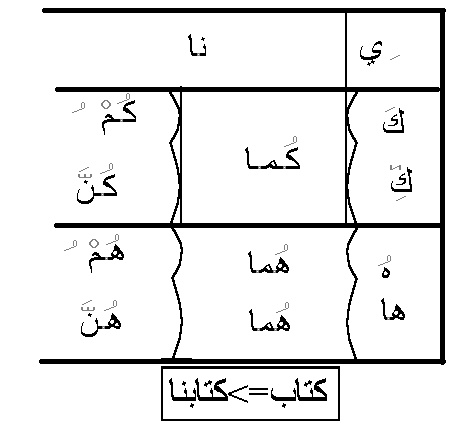Arabic/Pronouns/Charts
Compact Pronoun Charts
[edit | edit source]How the following pronoun charts work: The numbers before the semicolons indicate person. 1st person is used when you are talking about yourself, 2nd person to someone, and 3rd about someone/something.
The first word, after the number is in the Singular form. A comma separating two words means the first one of those two words is masculine, the other is feminine. A semicolon indicates a change in number. After the first comma is the dual and plural forms. If they are different there will be comma separating the dual and plural forms.
Plural forms are reserved for animate objects. Dual forms are not plural forms. Plural inanimate objects are treated as feminine singular.
The feminine plural form is only used when all members of the group referred to are feminine. The same applies to the dual.
<<Person>>: <<singular>> ; <<dual>> ; <<plural>>
Question Words:
- مَنْ
man = who
- متى
mataà = when
- أين
aina = where
- ماذا
maadħaa = what (before verb)
- ما
maa = what (before noun)
- لِماذا
limaadħaa = why
- كَيفَ
kaifa = how
- لِمَن
li-man = whose
- كَمْ
kam = how many/how much
Subject Pronouns:
1: anâ ; nahžnu
2: anta, anti ; antumaa ; antum, antunna
3: huwa, hiya ; humaa,humaa ; hum,hunna

Possessive Adjectives are always suffixed to a noun:
1: iî/-ya ; -naa
2: -ka,-ki ; -kumaa ; -kum, -kunna
3: -huú**, -haa ; -humaa,-humaa ; -hum,-hunna

Object Pronouns suffixed to verbs:
1: -nii ; -naa
ArObjectPronouns.gif
Dative: li + noun Or one of the following pronouns
1: lii/liya ; lanaa
2: laka, laki ; lakumaa ; lakum,lakunna
3: lahuu, lahaa; lahumaa, lahumaa ; lahum, lahunna
Possessive Pronouns: li + subject pronoun. Sometimes the word mulk meaning property is used.Sometimes the dative is used as a possessive noun.
Relative pronouns: (In English: which, who, that)
X: Elladħii, Ellatii; ; Elladħiina,
This (default one, in English "that" is default)
X: Haadħaa,Haadħihii; ;Haaŵulaa'i,
That
X: Dħaalika,Tilka ; ; Ulaaŷika
The word "inna" usually starts sentences and joins with a pronoun in the following manner. When it doesn't begin a sentence it is best translated as "that", it has also been translated as "verily". There is no adequete way to translate it into English.
The following are sometimes used instead of placing subject pronouns after "inna".
1: inna-nii (in-nii) ; inna-naa (in-naa)
2: inna-ka,inna-ki ; inna-kumaa ; inna-kum,inna-kunna
3: inna-huu,inna-haa ; inna-humaa,inna-humaa ; inna-hum, inna-hunna
Using the word "in" to mean "inna" is archaic.
The word "anna" works exactly the same way. Just change the "i" to an "a".
The word "laakin", meaning usually ends like inna when the subject is being mentioned, in which case it becomes "laákinna".
(huwa) qaala anna-nii... He said that I...
Laákin-nii... but I
The following are really close in meaning but the first kind is rarely found.
Inna anâ... Inna-nii
Laakin anâ... Laakinna-nii
Gender
[edit | edit source]- f-female (The pronoun represents a woman, or a girl, or a grammatically feminine word)
- m-masculine (The pronoun represents a man, or a boy, or a grammatically masculine word)
Note: Non-human objects, as with the case in Romance Languages, must be either masculine or feminine. For example "book" (كتاب) is masculine, and so uses the subject pronoun "هو". "Library," (مكتبة) however, is feminine, and so uses the subject pronoun "هي". However, ALL non-human plurals take the feminine singular. (e.g. libraries = هي, books = هي)
سيارة meaning "car".
سيارات meaning "cars".
- السيارة --> هي(as-saiyaarah->hiya)
- السيارات --> هي(as-saiyaaraat->hiya)
but
أم meaning "mother".
أمهات meaning "mothers".
- الأم-->هي(al-um-->hiya)
- الأمهات-->هن(al-ummuhaat-->hunna)
